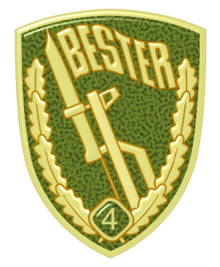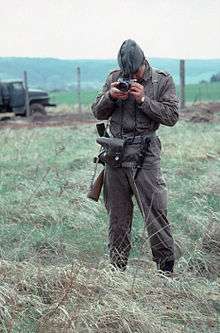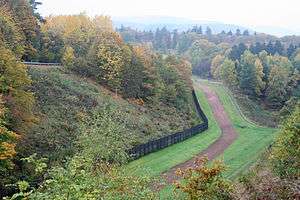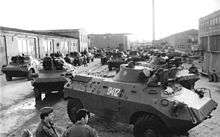Border Troops of the German Democratic Republic

The Border Troops of the German Democratic Republic, in German Grenztruppen der DDR, were a military force of the GDR and the primary force guarding the Berlin Wall and the border between East and West Germany. The Border Troops numbered at their peak approximately 47,000 troops. Except the Soviet Union, no other Warsaw Pact country had such a large border guard force.
The border guards were responsible for many deaths at the Berlin Wall as well as suffering from numerous casualties in the line of duty.
History

By December 1945—within six months of the end of the war—each of the five states in the Soviet occupation zone had a central police force, in clear violation of the Yalta and Potsdam agreements. In early January 1946, the term Volkspolizei (People's Police) was applied publicly to the new police forces in East Germany, and in August of the same year these forces were placed under the central control of the newly created German Administration of the Interior, headed by Erich Reschke. In November 1946, the Sowjetische Militäradministration in Deutschland (SMAD) directed the organization of the Deutsche Grenzpolizei (German Border Police), actually formed on 1 December 1946. The initial 3,000 recruits were organized and trained from People's Police resources, and by April 1948 the branch numbered 10,000, the total reaching 18,000 in 1950. The Grenzpolizei were armed and organised like a police force; and were subordinate to the Main Administration of the Border Police and Alert Units of the German Administration of the Interior. Eventually, the East German regime demanded a reorganization of the force along military lines, similar to their Soviet counterparts, the USSR Border Troops. In 1961, the Grenzpolizei were reorganized as the Grenztruppen der DDR. As part of the reorganization, the Grenztruppen der DDR were moved from the GDR Ministry of the Interior to the GDR Ministry of National Defense (MfNV). Although the border troops were originally part of the National People's Army (NVA), in 1973 they were separated from the NVA and reported thereafter directly to the MfNV.
While wearing standard NVA uniforms, the border troops had their own dark green arm-of-service colour, and their service and dress uniforms bore a green cuff title with white lettering - Grenztruppen der DDR - on the left arm. From 1973 on, service in the Grenztruppen der DDR was voluntary - no draftees involuntarily served in its ranks after 1973, as opposed to the NVA.
In contrast to the massive efforts along the borders with the West, there were only about 600 members of the Grenztruppen assigned to guard the GDR's borders with Czechoslovakia and Poland.
On 1 July 1990, the border control regime along the borders with West Germany and West Berlin was ended. In September 1990, shortly before the reunification of Germany, the Grenztruppen der DDR were disbanded; its border patrol duties along united Germany's eastern frontiers were assumed by the Bundesgrenzschutz (Federal Border Guard - later Bundespolizei or Federal Police).
Pass and Control Units
For most visitors to East Berlin and the GDR, including persons who utilized the land transit routes (road and rail) between West Germany and West Berlin, their exposure to the Grenztruppen der DDR consisted of dealing with the members of the "Pass and Control Units" (Paß- und Kontrolleinheiten - PKE) who processed travellers passing through the GDR's Grenzübergangsstellen (border crossing points). Although they wore Grenztruppen uniforms, the members of the PKE were in fact members of the 6th Main Department (Hauptabteilung VI) of the GDR Ministry of State Security (Ministerium für Staatssicherheit der DDR - "Stasi").
Organizational structure
Chiefs of the Deutsche Grenzpolizei (1946-1961) and the Grenztruppen der DDR (1961-1990)
- 1952 Richard Smolorz
- 1952–55 Hermann Gartmann
- 1955–57 Heinrich Stock
- 1957 Hermann Gartmann
- 1957–60 Paul Ludwig
- 1960–79 Generaloberst (Colonel General) Erich Peter
- 1979–90 Generaloberst Klaus-Dieter Baumgarten
- 1990 Generalmajor (Major General) Dieter Teichmann
The units of the Grenztruppen der DDR were organised in the same manner as ordinary NVA army units. The structure listed immediately below was that which existed prior to 30 November 1989.
Major units and locations
National headquarters
The headquarters of the Grenztruppen der DDR was located at Pätz (a small village southeast of Berlin in the present-day state of Brandenburg), near Königswusterhausen.
Regional headquarters
The Grenzkommando Nord (GKN) (Border Command North), with headquarters at Stendal (in the present-day state of Saxony-Anhalt) was responsible for the northern sector of the East German border. The GKN consisted of six frontier troops regiments, two training regiments, a helicopter flight and some smaller support units.
Commanders:
- Oberst Harald Bär (1 Feb 1971 - 31 Dec 1981)
- Oberst Johannes Fritzsche (1 Jan 1982 - 30 Nov 1989)
- Grenzregiment 6 "Hans Kollwitz"
- Grenzregiment 8 "Robert Abshagen"
- Grenzregiment 20 "Martin Schwantes"
- Grenzregiment 23 "Wilhelm Bahnik"
- Grenzregiment 24 "Fritz Heckert"
- Grenzregiment 25 "Neithardt von Gneisenau"
- Grenzausbildungsregiment 5 "Gustav Sobottka"
- Grenzausbildungsregiment 7 "Martin Hoop"
- Pionierkompanie 25
- Sicherungskompanie 25
- Stabs- und Versorgungsbataillon 25
- Musikkorps
The Grenzkommando Süd (GKS) (Border Command South), with headquarters at Erfurt, guarded the southern border sector. The organizational structure of the GKS was similar to that of the GKN, with six frontier troops regiments, two training regiments, a helicopter flight and some smaller support units.
Commanders:
- Oberst Gerhard Lorenz (1 Feb 1971 - 30 Oct 1973)
- Oberst Klaus-Dieter Baumgarten (1 Nov 1973 - 14 Apr 1978)
- Oberst Walter Tanner (15 Apr 1978 - 31 Oct 1982)
- Oberst Heinz Janshen (1 Nov 1982 - 30 June 1987)
- Oberst Dieter Hoffmann (1 July 1987 - 30 Nov 1989)
Order of battle:
- Grenzregiment 1 "Eugen Levine"
- Grenzregiment 3 "Florian Geyer"
- Grenzregiment 4 "Willi Gebhardt"
- Grenzregiment 9 "Konrad Blenkle"
- Grenzregiment 10 "Ernst Grube"
- Grenzregiment 15 "Herbert Warnke"
- Grenzausbildungsregiment 11 "Theodor Neubauer"
- Grenzausbildungsregiment 12 "Rudi Arnstadt"
- Pionierkompanie 27
- Sicherungskompanie 27
- Stabs- und Versorgungsbataillon 27
- Musikkorps
The Grenzkommando Mitte (GKM) (Border Command Center), with headquarters at Berlin-Karlshorst, manned the crossing points into West Berlin and guarded the entire border perimeter surrounding West Berlin. The GKM consisted of six frontier troops regiments, one border crossing point regiment, two training regiments, an artillery regiment and some smaller support units.
Commanders:
- Oberst Bernhard Geier (1 May 1971 - 31 Aug 1979)
- Generalmajor Erich Wöllner (1 Sep 1979 - 30 Apr 1990)
- Oberst Günther Leo (1 May 1990 - 30 Sep 1990)
Order of battle:
- Grenzregiment 33 "Heinrich Dorrenbach"
- Grenzregiment 34 "Hanno Günther"
- Grenzregiment 35 "Nikolai Bersarin"
- Grenzregiment 36 "Walter Husemann"
- Grenzregiment 38 "Clara Zetkin"
- Grenzregiment 42 "Fritz Perlitz"
- Grenzregiment 44 "Walter Junker"
- Grenzausbildungsregiment 39 "Ho Chi Minh"
- Grenzausbildungsregiment 40 "Hans Coppi"
- GÜST-Regiment "Walter Husemann"
- Artillerieregiment 26
- ABC-Abwehrkompanie 26
- Amphibische Pionierkompanie 26
- Instandsetzungskompanie 26
- Kfz-Transportkompanie 26
- Kompanie Chemische Abwehr 26
- Nachrichtenkompanie 26
- Nachrichtenwerkstatt 26
- Sicherungskompanie 26
- Musikkorps
.svg.png)
.svg.png)
The Grenzkommando Küste (GKK) (Coastal Border Command), with headquarters at Rostock, deployed a coastal brigade (Grenzbrigade Küste) consisting of twelve marine battalions and several boat battalions and companies to guard the GDR's relatively small coastline along the Baltic Sea. For command-and-control purposes, the GKK was incorporated into the GDR's "People's Navy" (Volksmarine).
Reorganization in 1989
In accordance with a June 1989 decision of the National Defense Council of the GDR, the Grenztruppen der DDR were extensively reorganized as of 30 November 1989. The personnel strength was reduced by approximately 17 percent, while the number of headquarters units was reduced from 50 to 24.
In the place of the previous command structure, six border district commands (Grenzbezirkskommandos), 16 border county commands (Grenzkreiskommandos) and two border training centers (Grenzausbildungszentren) were created. The Grenzbezirkskommandos reported to the national headquarters.
- Grenzbezirkskommando 1, Schwerin
with three Grenzkreiskommandos:
- Grevesmühlen / Gadebusch
- Hagenow
- Ludwigslust
- 18 Grenzkompanien
- two Bootskompanien
- three Reservegrenzkompanien
- Grenzbezirkskommando 2, Magdeburg
with five Grenzkreiskommandos:
- Salzwedel / Osterburg
- Klötze
- Haldensleben
- Halberstadt / Oschersleben
- Wernigerode
- 27 Grenzkompanien
- seven Reservegrenzkompanien
- Grenzbezirkskommando 3, Erfurt
with four Grenzkreiskommandos:
- Nordhausen
- Worbis/Mühlhausen
- Heiligenstadt
- Eisenach
- 22 Grenzkompanien
- 5 Reservegrenzkompanien
- Grenzbezirkskommando 4, Suhl
with four Grenzkreiskommandos:
- Bad Salzungen
- Meiningen
- Hildburghausen
- Sonneberg / Neuhaus
- 29 Grenzkompanien
- four Reservegrenzkompanien
- Grenzbezirkskommando 5, Gera
no assigned Grenzkreiskommando
- eight Grenzkompanien
- two Reservegrenzkompanien
- Grenzbezirkskommando 7, Karl–Marx-Stadt
no assigned Grenzkreiskommando
- three Grenzkompanien
- one Reservegrenzkompanie
The four Grenzausbildungsregimenten were consolidated into two Grenzausbildungszentren:
- Grenzausbildungszentrum 16 (locations in Halberstadt und Dingelstedt)
- Grenzausbildungszentrum 36 (locations in Plauen und Eisenach)
The two training centers reported directly to the national headquarters, along with the training schools for Grenztruppen officers, officer candidates and NCOs.
Translation of German terms into English
- ABC-Abwehrkompanie - Nuclear Biological Chemical-defence company
- Amphibische Pionierkompanie - amphibious engineer company
- Artillerieregiment - Frontier Troops artillery regiment
- Grenzausbildungsregiment - Frontier Troops training regiment
- Grenzausbildungszentrum - Frontier Troops training center'
- Grenzaufklärer (GAK) - Border Reconnaissance
- Grenzkompanie - Frontier Troops company
- Grenzregiment - Frontier Troops regiment
- GÜST (Grenzübergangsstelle)-Regiment - border crossing point regiment
- Instandsetzungskompanie - repair company
- Kfz-Transportkompanie - truck transport company
- Kompanie Chemische Abwehr - chemical defence company
- Musikkorps - parade band
- Nachrichtenkompanie - signal company
- Nachrichtenwerkstatt - communication support company
- Pionierkompanie - engineer company
- Reservegrenzkompanie - Reserve Frontier Troops company
- Sicherungskompanie - security company
- Stabs- und Versorgungsbataillon - staff & supply battalion
Subordination of the Deutsche Grenzpolizei (1948-1961)
13 Jul 1948-11 Oct 1949: Controlled by the DVdI
12 Oct 1949-1952: Controlled by the MdI
1952-16 Jun 1953: Controlled by the MfS
17 June 1953 – 1955: Controlled by the MdI
1955-28 Feb 1957: Controlled by the MfS
1 Mar 1957-14 Sep 1961: Controlled by the MdI
Sep 1961 -1973:Controlled by the NVA, the Grenzpolizei were reorganized as the Kommando der Grenztruppen (KdoGT) der NVA and were moved from the GDR MdI to the GDR Ministry of National Defense (MfNV)
1973 - 1990:Controlled directly by the MfNV. Renamed the Grenztruppen der DDR
1990 - 1994:Controlled by Bundeswehr. The border guards' numbers were rapidly reduced. Half were dismissed within five months of the opening of the border.[1] The border was abandoned and the Grenztruppen were officially abolished on 1 July 1990,;[2] all but 2,000 of them were dismissed or transferred to other jobs. The Bundeswehr gave the remaining border guards and other ex-NVA soldiers the task of clearing the border fortifications, which was only completed in 1994. The scale of the task was immense, as not only did the fortifications have to be cleared but hundreds of roads and railway lines had to be rebuilt.[3]
Training and equipment
Training for Grenztruppen soldiers was provided by the four training regiments; after the reorganization of 30 November 1989 (see below), the four regiments were consolidated into two training centers. Training for noncommissioned officers was held at the Unteroffiziersschule der Grenztruppen der DDR "Egon Schultz“ in Perleberg. Training for dog handlers was conducted in Wilhelmshorst. Grenztruppen officers and officer candidates were trained at the Offiziershochschule der Grenztruppen der DDR "Rosa Luxemburg“ in Suhl (previously located in Plauen). Border Troop regiments were trained similar to regular infantry, but were much more lightly equipped than comparable NVA infantry formations, with the heaviest weapon being the RPG-7 grenade launcher. To increase their capability to search for persons attempting to flee the GDR, most units had German Shepherd dogs. A regiment consisted of around 1,500 men divided into three battalions of four companies each. These regiments also had an anti-tank battery, a mortar battery and an engineer company.
Units of the Grenzkommando Mitte were mechanized, with PSzH-IV and FUG armoured vehicles.
Refugee Shootings Along the Berlin Wall and the Inner-German Border

Undoubtedly the most controversial aspect surrounding the Grenztruppen der DDR concerns those who were killed or wounded while attempting to flee East Germany into the West. Even today, the topic of the "shoot-to-kill order" (Schießbefehl) is quite sensitive in Germany, East and West. According to information released by the "Working Group 13th of August" (Arbeitsgemeinschaft 13. August e.V.) on 13 August 2004, 1065 persons were killed along the GDR's frontiers and coastline, including 37 Grenztruppen soldiers killed during escape attempts. Many more were wounded.
The Berlin Public Prosecution Department estimates that about 270 'proven' deaths on the border were due to acts of violence by GDR border security guards, including deaths caused by mines and automatic firing devices. However, the Central Assessment Group for Governmental and Organized Crimes (German: ZERV), which existed from 1991 to 2000 as a branch of the Berlin Police, registered 421 suspected cases of killings by armed GDR border guards.[4]
To encourage the troops, the GDR government gave distinctions, extra liberty and premiums to a soldier who had used his gun in earnest at the border. If he had killed a refugee, he got a gold watch, but was also transferred to another unit to avoid bullying from his own unit buddies.[5]
Line of Duty Deaths
29 Grenztruppen died in the line of duty. The first three deaths occurred at the time of the Soviet occupation zone, after the founding of the German Democratic Republic in October 1949 until its end of 1990 were a further 26 border policemen and border soldiers were killed. Of these 29, 20 died on the inner-German border, eight in Berlin at the Wall and one on the border with Czechoslovakia. Concrete information on the individual perpetrators and their motives is not possible in all cases. Known perpetrators were persons attempting to flee to the West (either civilian or military), citizens of West Germany assisting such escapes, or members of either West German police/border guard units or NATO armed forces.
The list of names of the deceased are only occasional light on the cause of death and killers if known.
- Paul Sager († 10. November 1948)
- Gerhard Hofert († 3. August 1949)
- Fritz Otto († 1. September 1949)
- Siegfried Apportin († 2. July 1950)
- Herbert Liebs († 21 February 1951)
- Werner Schmidt († 2 March 1951)
- Heinz Janello († 2 March 1951)
- Rudolf Spranger († 7 August 1951)
- Manfred Portwich († 27 October 1951)
- Ulrich Krohn († 16 May 1952)
- Helmut Just († 30 December 1952)
- Waldemar Estel († 3 September 1956)
- Jörgen Schmidtchen († 18 April 1962; army deserter shot dead by two cadets from the flak school at Stahnsdorf.[6])
- Manfred Weiss († 19 May 1962)
- Peter Göring († 23 May 1962)
- Reinhold Huhn († 18 June 1962)
- Rudi Arnstadt († 14 August 1962)
- Günter Seling († 30 September 1962)
- Siegfried Widera († 8 September 1963; killed by refugees on August 23, 1963)
- unknown Volkspolizei member († 15 September 1964)
- Egon Schultz († 5 October 1964)
- Hans-Adolf Scharf († 10 June 1966)
- Rolf Henniger († 15 November 1968)
- Lutz Meier († 18 January 1972)
- Klaus-Peter Seidel, and Jürgen Lange (both † 19 December 1975; both shot dead by deserting army soldier Werner Weinhold.[7])
- Ulrich Steinhauer († 4 November 1980; a postal officer from his post deserter killed with a shot in the back. The offender managed to escape, he was convicted in West Berlin in 1981 for manslaughter in a youth custody of 6 years.[8])
- Klaus-Peter Braun († 1 August 1981)
- Eberhard Knospe († 5 May 1982)
- Uwe Dittmann († 22 March 1985)
- Horst Hnidyk († 3 August 1989)
See also
- Grepo
- Crossing the inner German border
- Development of the inner German border
- Fortifications of the inner German border
- Escape attempts and victims of the inner German border
- Fall of the inner German border
References
| Wikimedia Commons has media related to Border Troops of the German Democratic Republic. |
- ↑ Koenig, Robert L. (22 April 1990). "Unity replaces fence — German social, economic barriers next to fall". St. Louis Post-Dispatch.
- ↑ Rottman (2008), p. 58.
- ↑ Rottman, p. 61
- ↑ "Germany and the German Democratic Republic - Truth and justice". Amnesty International, Daan Bronkhorst. June 2006. Retrieved 2008-03-11.
- ↑ Rühmland, Ulrich (1978). Die NVA in Stichworten (in German). Bonn-Röttgen: Bonner Druck- und Verlagsgesellschaft.
- ↑ Hans-Hermann Hertle: The Berlin Wall - Monument of the Cold War. Ch. Links, Berlin 2007, S. 107–109. ISBN 3-86153-463-0 . Ch links, Berlin 2007, p. 107-109. ISBN 3-86153-463-0.
- ↑ Helmut Müller-Enbergs (Editor): Who was who in the GDR?, Volume 2, M - Z. Ch. Links, Berlin, 2006, entry Weinhold, Werner S. 1070. ISBN 3-86153-364-2 . 1070th ISBN 3-86153-364-2.
- ↑ Hans-Hermann Hertle, Konrad Jarausch and Christoph Kleßmann: Fall of the Berlin Wall and. Ch. Links, Berlin 2002, S. 299. ISBN 3-86153-264-6 . Ch links, Berlin 2002, p. 299 ISBN 3-86153-264-6.




